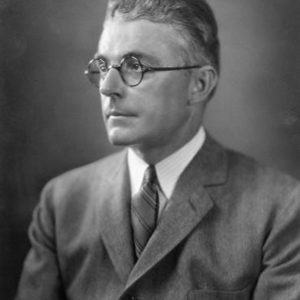1920s: Watson
Lumen Learning; Wikimedia contributors; and Diana Lang
Watson: Behaviorism
John B. Watson was an influential American psychologist whose most famous work occurred during the early 20th century at Johns Hopkins University. Watson conducted research on animal behavior, child-rearing, and advertising. Along with this research, he conducted the controversial “Little Albert” study.[1]

Watson believed that an objective analysis of the mind was impossible; therefore, he preferred to focus directly on observable behavior and attempted to modify it. Watson was a major proponent in shifting the focus of psychology from the mind to behavior, and this approach of observing and controlling behavior came to be known as behaviorism. A major object of study by behaviorists was learned behavior and its interaction with the inborn qualities of the organism.
Behaviorism commonly used animals in experiments under the assumption that what was learned using animal models could, to some degree, be applied to human behavior. This famous quote from Watson explains his contentions:[2]
“Give me a dozen healthy infants, well-formed, and my own specified world to bring them up in and I’ll guarantee to take any one at random and train him to become any type of specialist I might select – doctor, lawyer, artist, merchant-chief and, yes, even beggar-man and thief, regardless of his talents, penchants, tendencies, abilities, vocations, and race of his ancestors. I am going beyond my facts and I admit it, but so have the advocates of the contrary and they have been doing it for many thousands of years.”
Watson believed that children should be treated as young adults. In his book, he warned against the inevitable dangers of a mother providing too much love and affection. Watson’s slogan was ‘not more babies but better brought up babies’. Watson argued for the nurture side of the nature-nurture debate and contended that everything is built into a child through their interactions with their environment.
Thus, according to Watson, parents and caregivers hold complete responsibility for their children’s actions since they choose the environment into which their child is reared.[3] Based on the results from his “Little Albert” study, Watson concluded that caregivers can shape a child’s behavior and development simply by taking control of all stimulus-response associations.
The Little Albert Experiment (1920)
The goal of the Little Albert Experiment was to show how the principles of classical conditioning could be applied to a 9-month-old boy. Watson and his assistant conditioned “Little Albert” to fear a white rat by clanging an iron rod when a white rat was shown to Albert.[4]
First, they presented a white rat to the boy and observed that he was not afraid of it. Second, they showed him a white rat and then clanged an iron rod. “Little Albert” responded by crying. This second presentation was repeated several times. Finally, the researchers introduced the white rat by itself and the boy showed fear.
Later, in an attempt to see if the fear transferred to other objects, Watson presented Albert with a rabbit, a dog, and a fur coat. “Little Albert” cried at the sight of all of them.[5]
Watch this video of the Little Albert study to get an overview of how the study was carried out.
This study demonstrated how emotions could become conditioned responses. Analyses of Watson’s film footage of Albert have caused some to conclude that “Little Albert” may have had cognitive or developmental delays.[6] An ethical problem with the study was that Watson never reversed this conditioned response in Little Albert.[7]
Watson Today
Watson’s advice to treat children with respect, but with relative emotional detachment, has been strongly criticized. However, behaviorism is still evident today and is largely responsible for establishing psychology as a scientific discipline through its objective methods and experimentation. It is currently used in behavioral and cognitive-behavioral therapies, in classroom settings, and in child-rearing.
- Objective analysis of the mind was impossible, therefore Watson coined “behaviorism” where the focus of psychology is to observe and control behavior.
- Individuals can be trained to behave in certain ways as a result of their environment and the types of stimuli applied.
- The Little Albert experiment—emotional responses can be conditioned in humans.
- This chapter is an adaptation of The History of Psychology Continued by Lumen Learning, and is used under a CC BY 4.0 license. ↵
- Watson, J. B. (1930). Behaviorism (Revised edition). University of Chicago Press. ↵
- Watson, J. B. (1928). Psychological Care of Infant and Child. New York: W.W. Norton Company, Inc. ↵
- This section is an adaptation of Little Albert Experiment (1920) on Wikipedia and is used under a CC BY SA 3.0 license. ↵
- Watson, J. B., & Rayner, R. (1921). Studies in infant psychology. The Scientific Monthly, 13(6): 493–515. ↵
- Irons, G. (2012). Little Albert: A neurologically impaired child. History of Psychology, 15(4): 302–327. doi:10.1037/a0026720. ↵
- O'Donnell, J. M. (1985). The origins of behaviorism. New York University Press. ↵
The study of observable behavior. Behaviorism theorizes that behaviors can be observed, recorded, measured, and reproduced by introducing specific stimuli into an organism's environment.

